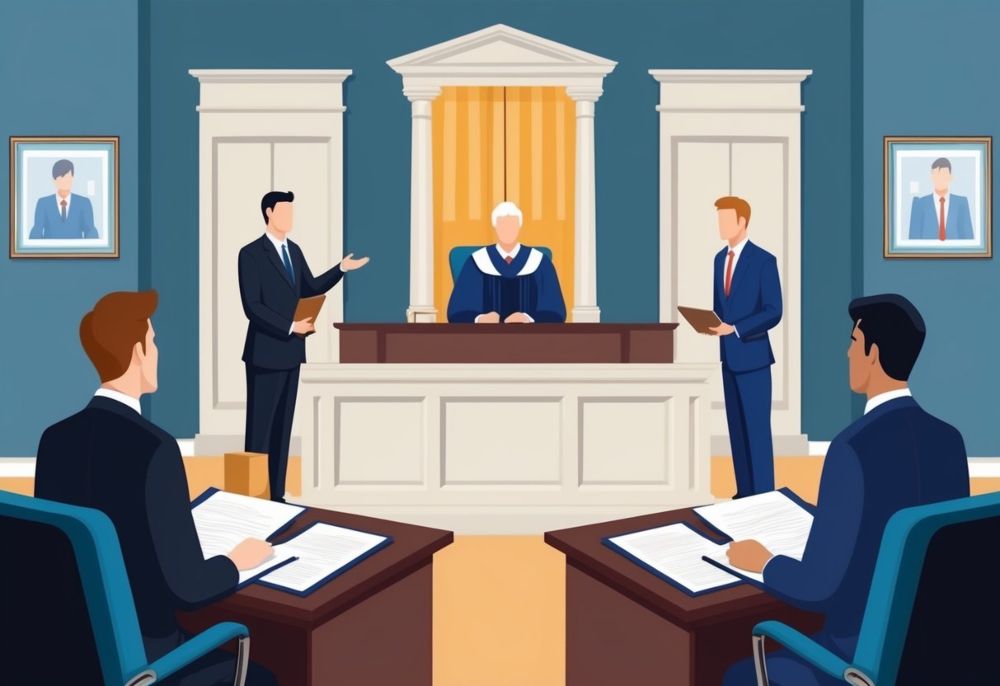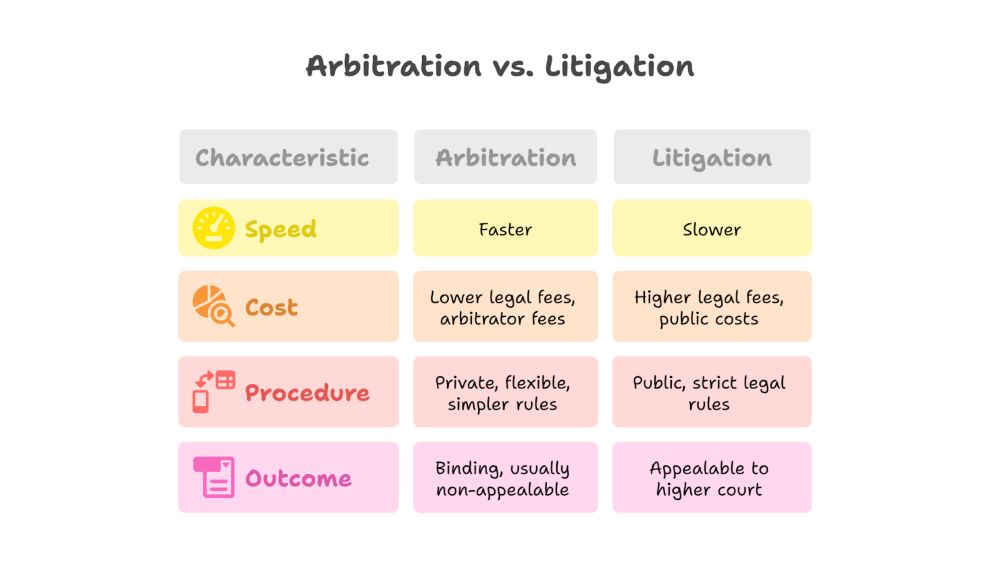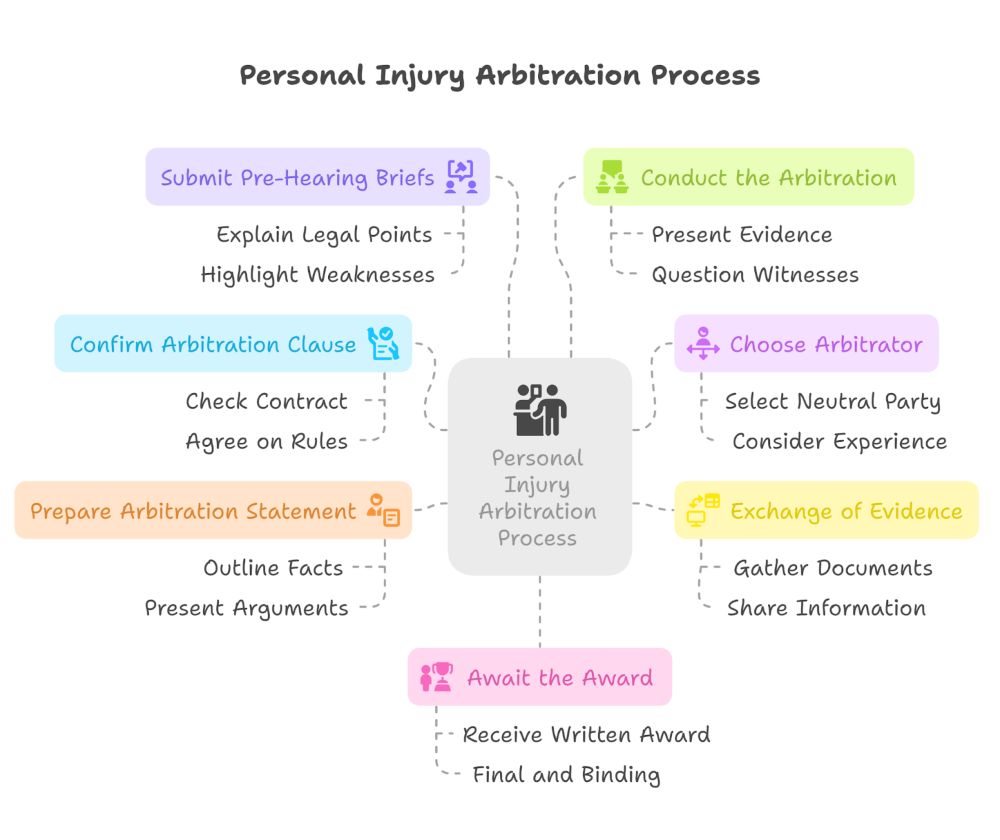

When someone gets hurt and files a personal injury claim, the process can feel long and overwhelming. Most people don’t realize there are options besides a traditional court trial.
Arbitration offers a faster, less stressful, and private way to resolve personal injury claims.
In this process, a neutral arbitrator reviews the facts and decides, often bringing both sides to a fair solution—no courtroom required.
Understanding how personal injury arbitration works helps claimants and defendants know what to expect.
The steps, rules, and outcomes differ from a trial, which can be confusing initially.
By learning the key parts of an injury arbitration checklist, anyone involved can feel more confident and organized for what’s ahead.
Table of Contents
Key Takeaways
- Arbitration offers a quicker, private alternative to court for personal injury claims.
- Both sides must prepare evidence and follow a step-by-step process unique to arbitration.
- Understanding the differences between mediation, arbitration, and litigation can help people choose the best way to resolve their injury claims.
What Is Arbitration in Personal Injury Cases?

Arbitration is a way to resolve personal injury claims without going to court. It’s a legal process in which both parties share their sides, and a neutral third party decides.
Definition and Legal Framework
Arbitration in personal injury cases falls under alternative dispute resolution. It’s often used to save time and money compared to a trial.
Both sides agree to present evidence and arguments to an arbitrator or a panel. The law sets arbitration rules, and many states, like Florida, have their own guidelines and national ones.
The process usually starts when both parties agree to arbitration in a contract or after a dispute begins. Steps include choosing an arbitrator, holding a hearing, and presenting evidence.
Arbitration is private and less formal, and the final decision is usually binding. That means the ruling is final and difficult to change later.
Who Arbitrates These Cases?
An arbitrator handles the process. This neutral person is often a lawyer, judge, or someone with special training in injury law.
Parties can agree on who the arbitrator will be, or sometimes an organization appoints one. In Florida, personal injury arbitrators often have experience with state laws and handling injury claims.
Some states require certain qualifications or certify arbitrators for these matters. The arbitrator listens to both sides, reviews all the evidence, and decides the outcome.
Local bar associations and private groups keep lists of qualified arbitrators. The choice of arbitrator can affect the fairness and efficiency of the process.
When and Why Arbitration Is Used
People sometimes choose arbitration to resolve a personal injury case when they want a faster, private, or less formal process. Sometimes, an agreement or insurance policy requires it.
Voluntary vs. Mandatory Arbitration
Voluntary arbitration happens when both parties, the injured person and the other side, agree to it after the injury. They can choose the arbitration service and even name the arbitrator they trust most.
Mandatory arbitration is different. Here, an agreement or insurance policy requires arbitration if there’s a dispute. For example, AAA personal injury arbitration (American Arbitration Association) involves cases where the process isn’t optional.
Many auto insurance companies use mandatory clauses for crash claims. Voluntary arbitration gives more flexibility in setting terms. In contrast, mandatory arbitration can limit choices, so reading agreements closely is necessary. Whether to arbitrate often comes down to the terms and possible outcomes. If you’re wondering, “Should I arbitrate my injury case?” It’s worth weighing the pros and cons.
Common Use Cases
Arbitration is common in personal injury claims where speed and privacy matter. Typical examples include car accidents, workplace injuries, or medical disputes.
Insurance policies might have clauses that automatically apply arbitration to specific injuries. Arbitration often resolves more minor disputes with less money at stake. It’s also helpful for those who want to avoid a public trial or a long court process.
Experts in injury law say arbitration is usually faster and less expensive than court. Some arbitration success rates in personal injury cases show that parties often settle.
Each case is different, though; it is important to weigh the benefits against the limits on appeals or decisions in arbitration.
Facing delays with your injury claim? The Mediation Group helps resolve personal injury cases quickly through arbitration. Call (954) 474-8700 to schedule your session.
If you’re ready to get started, call us now!
Personal Injury Arbitration vs. Litigation: Key Differences

Arbitration and litigation resolve personal injury disputes but differ in speed, cost, process, and outcomes. Knowing these differences helps injured parties make smarter choices about their claims.
Speed, Cost, and Procedure
Arbitration is usually faster than litigation. Many cases finish in months, not years, because arbitration doesn’t rely on crowded court schedules or as many formal rules.
Litigation can mean waiting for court openings, which can drag things out. The cost of arbitration versus court lawsuits can vary. Arbitration often has fewer hearings and less paperwork, so legal fees might be lower.
But parties pay for the arbitrator’s time, which can add up. The public generally pays for court cases, but legal processes and extra steps may increase total expenses over time.
Arbitration procedures are private and more flexible. Hearings get scheduled when it works for everyone, and evidence rules are simpler, which speeds things up.
Litigation follows strict legal rules, and most court cases go on the public record. For a lot of people, privacy and flexibility make arbitration appealing.
Binding vs. Non-Binding Outcomes
Most personal injury arbitrations are binding, so the arbitrator’s decision is final. Parties usually can’t appeal, even if they don’t like the outcome. This brings faster closure, but there’s little chance to try the case again.
Litigation results can often be appealed to a higher court. If someone thinks the judge or jury got it wrong, that adds another layer, but appeals take more time and cost more.
Some arbitrations are non-binding, so either party can reject the result and go to court. Binding arbitration is more common in personal injury claims, since both sides know the matter will be settled for good.
Choosing between these options depends on how much you value finality, speed, and control over the outcome.
Personal Injury Arbitration Checklist (Step-by-Step)

Arbitration allows people to resolve injury claims without a public trial. The process has several key steps, each requiring solid preparation and attention to detail.
Step 1 – Confirm Arbitration Clause or Agreement
Before you start, check for an arbitration clause in the contract. Insurance policies or other agreements might require disputes to be resolved through arbitration instead of the court.
If there is no arbitration agreement, both parties can still agree to arbitrate to resolve the claim. This step lays the foundation for everything else.
Look closely at the contract or policy wording. If it’s unclear, a lawyer can help explain the terms. Everyone must agree on the rules and scope of arbitration, including which claims are covered.
Without a valid agreement, arbitration cannot proceed. Getting this straight early on helps avoid headaches later.
Step 2 – Choose Arbitrator or Panel
The parties need to pick a neutral arbitrator or sometimes a panel. The arbitrator acts like a private judge for the dispute.
Some contracts name a specific person or organization, while others require both sides to agree on one. Picking someone with personal injury experience makes things go smoother.
When both sides agree, they might choose from a list or use an organization that offers arbitration services. The arbitrator should be fair and have no conflicts of interest.
This choice matters—a lot. Both sides should think about experience, background, and reputation.
Step 3 – Exchange of Evidence
Both sides gather and exchange documents, witness lists, expert reports, and other key information. This step is similar to the discovery phase in court, but is usually quicker and less formal.
Items exchanged might include medical records, police reports, photos, and bills. The process and timeline are usually set in the arbitration rules or by the arbitrator.
Sharing what’s needed helps prevent delays and keeps things fair. Full transparency makes the hearing run smoother and avoids last-minute surprises.
Step 4 – Prepare Arbitration Statement
Each party writes a case summary, often called an arbitration statement. This document outlines the main facts, legal arguments, injuries, and damages claimed.
The goal is to give the arbitrator a clear overview of what each side thinks happened and why they should win. A strong statement is organized and sticks to the facts.
It might include key evidence or refer to important documents. The statement can also address questions likely to come up during the hearing.
Step 5 – Submit Pre-Hearing Briefs
Attorneys or parties file written briefs before the hearing. These briefs explain the legal arguments and facts they plan to present.
The briefs might discuss liability, damages, and legal or evidence disagreements. Pre-hearing briefs help the arbitrator get ready and understand each side’s main points.
Usually, there’s a deadline for these briefs, set by the arbitrator or agreed on by both sides. Well-prepared briefs highlight weaknesses in the other side’s arguments and support their claims.
Some arbitrators set limits on how long or detailed these briefs can be.
Step 6 – Conduct the Arbitration
The arbitration hearing for a personal injury claim isn’t as formal as a court trial, but there’s still a process. Each party presents its side, submits evidence, and questions witnesses.
The arbitrator listens, reviews the facts, and might ask questions to clear up certain points. Sometimes, the hearing wraps up in just a few hours.
Sometimes, it drags on for a day or more—it depends on how tangled the case is. Both sides must follow the arbitrator’s rules, like turning in documents early or adhering to set time limits.
The hearing’s main point is to let everyone explain their case to the arbitrator.
Step 7 – Await the Award
After the hearing, the arbitrator reviews the evidence and arguments before deciding. Usually, you get a written award that spells out the outcome and any damages or remedies.
The time to receive the award depends on the initial rules, but most people hear back within a few weeks. The outcome is almost always final and binding, with only a few ways to appeal.
Need clarity on arbitration rules? Let The Mediation Group guide your personal injury case from confusion to resolution—tap (954) 474-8700 to speak with our team.
If you’re ready to get started, call us now!
How to Prepare for Arbitration (Plaintiffs & Defendants)
Whether you’re the plaintiff or the defendant, getting ready for arbitration really matters.
You’ll want to gather all your case materials, plan your arguments, and consider what the other side might say.
Staying organized and paying attention to details makes a huge difference.
Organizing Case Materials
Both sides should gather every document that supports their claims or defenses. Medical records, bills, contracts, photos, emails—all of it helps.
Making a checklist isn’t a bad idea, just to be sure you don’t miss anything.
Arrange your evidence in order, by topic or date. Label witness statements and expert reports to make them easily accessible during arbitration.
Make copies for the arbitrator and the other side. Having everything organized means you can answer questions without scrambling.
Courts often suggest this approach because it saves time and cuts down on confusion.
Legal Strategy & Communication
You need a clear legal strategy. Plaintiffs should explain why the defendant is at fault and show what their injuries are worth.
Defendants should plan to challenge the plaintiff’s claims and bring evidence that reduces liability or damages. Talk to your witnesses about their testimony beforehand and ensure they’re available for the hearing.
Keep your arguments based on facts and focus on the strongest parts of your case. Prepare short but convincing opening and closing statements.
If you have a lawyer, meet often to review everything and practice answering tough questions. Good prep goes a long way when the arbitrator asks things on the spot.
Understand the Opponent’s Position
It pays to study what the other side will argue. Go over any documents or evidence they’ve shared—police reports, medical evaluations, written statements, whatever they’ve got.
You should try to spot gaps or weak spots in their story and develop questions to challenge their evidence or witnesses during arbitration.
Think ahead about possible settlement offers and decide what you’d accept. Knowing both sides’ strengths and weaknesses helps you avoid surprises.
This can really improve your chances of handling things confidently when it matters.
What Happens After Arbitration?
Once arbitration ends, what happens next depends on whether the outcome is binding or just advisory. The way awards get enforced and how appeals work matter for anyone dealing with a personal injury claim.
If the Award Is Binding
Most personal injury arbitrations end with a binding decision—an “award”—that both sides have to follow. It’s basically as serious as a court order.
The binding award gives everyone closure and usually keeps things out of court. If the arbitrator orders money or other actions, those have to happen within the set time frame.
The other party can ask a court to enforce the award if someone doesn’t comply. Courts almost always enforce these awards unless there’s clear fraud or serious misconduct.
That’s why binding arbitration is often a reliable way to wrap things up quickly.
If the Award Is Advisory
Sometimes, the arbitration award is just advisory, not binding. It’s not the norm, but sometimes both sides want a recommendation to help settle or avoid a long trial.
An advisory award doesn’t force anyone to do anything. The parties can choose to accept it or not.
If both sides agree, the advisory award can lead to a signed settlement and finish the claim. If one side doesn’t accept it, the case can head to court or dispute resolution.
Even so, an advisory award can shape later negotiations, since it shows how a neutral person sees the case.
Appeals or Challenges
Appealing a binding arbitration award is tougher than appealing a normal court decision. Courts will only overturn an award if there’s proof of fraud or bias or the arbitrator stepped outside their authority.
To challenge an award, you’d usually:
- Check the arbitration agreement for any appeal rights
- File a motion in court within the deadline (often 30 to 90 days)
- Clearly explain why you think the award should change or be canceled
Even if you appeal, courts rarely change arbitration awards. Advisory awards don’t need appeals since they aren’t final anyway.
Personal Injury Arbitration Checklist
This checklist is designed to help personal injury claimants, attorneys, and insurance representatives prepare for arbitration.
Use it to stay organized, meet requirements, and increase your chances of a smooth resolution.
| Step | Action Item | Documents / Notes |
| Step 1 | Check for Arbitration Clause | Look in the insurance policy or contract for binding/non-binding language |
| Step 2 | Select Arbitrator or ADR Provider | Agree on a neutral third party or service like AAA or JAMS |
| Step 3 | Submit Initial Arbitration Statement | Timeline of incident, injuries, legal issues, and damages |
| Step 4 | Exchange Evidence & Witness Lists | Medical records, photos, bills, expert reports, wage documentation |
| Step 5 | Prepare for Hearing Procedures | Understand the rules: questioning, evidence format, and expected timing |
| Step 6 | Attend and Present a Case | Have visuals ready, maintain professionalism, and follow the arbitrator’s guidance |
| Step 7 | Review Arbitration Award | Check whether the award is binding or advisory; follow up as needed |
Conclusion
Arbitration gives people another way to resolve personal injury claims, skipping the whole court ordeal. A neutral third party—yep, the arbitrator—listens to both sides and makes a decision.
Many go for arbitration because it usually wraps up faster and costs less than a full-blown trial. That alone makes it appealing.
Key things to remember about personal injury arbitration:
- It’s private, so the details stay out of public records.
- Both sides usually have to agree to use arbitration.
- The arbitrator’s decision is almost always final and tough to challenge.
Arbitration can save time and sidestep the endless delays that sometimes bog down court cases. If you’re after a quicker answer, this route might be worthwhile.
But let’s be real: not every claim is suitable for arbitration. Some cases are too tangled or involve too many parties, so that the court system might be better. Always review any contracts or chat with an attorney before you commit.
Ready to move your case forward? The Mediation Group offers reliable personal injury arbitration in Florida. Book now at themediationgroupinc.com or call (954) 474-8700.
Contact Us Today For An Appointment
Frequently Asked Questions
What is arbitration in a personal injury claim?
Arbitration is a legal process in which a neutral third party resolves a personal injury dispute outside of court. Depending on the agreement, the decision may be binding or non-binding.
Is arbitration faster than litigation for personal injury cases?
Yes. Arbitration typically resolves personal injury claims in 6–8 months, while litigation can take 1–2 years or longer due to court backlogs.
Is arbitration legally binding in personal injury cases?
Arbitration is binding only if both parties agree in writing. A binding arbitration decision has the same enforceability as a court judgment.
Can you appeal a personal injury arbitration decision?
In most cases, arbitration decisions cannot be appealed without fraud, corruption, or a serious procedural error.
What are the advantages of arbitration over a lawsuit?
Arbitration is faster, more private, and often less expensive than a lawsuit. It also involves less formal procedures and typically shorter hearings.
What should I bring to a personal injury arbitration?
Bring medical records, evidence of damages, photos, witness statements, and a summary of the incident. Your attorney may also submit a pre-hearing brief.
How much does personal injury arbitration cost?
Costs vary but are usually 30–50% less than litigation. Parties may split the arbitrator’s fee, and overall expenses are lower due to shorter timelines.